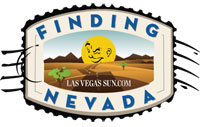Saturday, Sept. 21, 2013 | 5:15 p.m.
We’ve covered more than 1,000 miles over the past week– 1,065.9 miles to be exact, but who’s counting? – and we’re back in Las Vegas for a few days before we venture out again.
The Land Rover is covered in dried mud (it seems happier that way), and we have bags of dirty laundry. Although we’re exhausted, we’re thrilled. The first trip of the Finding Nevada project was kind of like the state itself – wide open, unexpected and fascinating.
Today alone, we went out to the Rhyolite ghost town and the Goldwell Open Air Museum near Beatty. If you search the Internet for the museum, you’ll probably see pictures of the ghostly white statues posed like Michaelangelo’s “The Last Supper” or the other art work that decorates the desert. That’s what I expected and, sure enough, I did.
What I didn’t expect to find was Richard Stephens, a retired art and English teacher at Beatty High School. Stephens is a member of the nonprofit group that runs the museum, and he was in the small museum building on Saturday waiting to show people around.
A longtime Nevadan, he was knowledgeable about the area and the artwork. He is also an artist himself – and a good one at that. He takes photos, paints and makes (and plays) flutes, which are available at the museum. He told stories about the art and the area, offered a variety of tips and suggestions and made the visit more enjoyable.
I was looking at a slab of rhyolite inside the museum building, and he answered my question before I could ask it:
“People ask what you can use rhyolite for,” he said, “and I tell them, ‘You can pick up a chunk and throw it at a snake or you can cuss at it – that’s what the miners drilling through it for gold did.’”
We’ll just take a picture, thanks.
• • •
At the Beatty Historical Museum, we met Nicole Altman, a native of Las Vegas who has lived around the world, including in Australia, Indonesia and New Guinea.
She said she knew she always wanted to come back to Nevada, but she wouldn’t have thought Beatty until she found a piece of land that she fell in love with. Now, she lives in Beatty full-time and dishes out information in a neat little museum and promotes the area. She gave us some ideas about what we could do and see, which we’ll save for another day.
I asked her what kind of souvenir would signify Beatty. She thought and mentioned the minerals in the region that attracted people. Beatty was “gold and dreams,” she said.
“There was no gold in Beatty,” Altman said. “One reason Beatty is still here, besides the highway , (is) Beatty has water.”
Of course. That’s a scarcity of water in the desert. Rhyolite didn’t have it, and when the mines went bust there, so went the town.
But does water symbolize the town? She thought again and suggest something else: a burro.
• • •
There are wild burros in various places around Nevada. But what makes them so special in Beatty?
We learned that there are burros who live in town. Not the burros you’ll see along the highway, but a group that actually lives in town. There’s Becca and Jackpot (mom and dad from what we could determine, but we couldn't find them to ask.) Regardless, they have a new baby that is, as of yet, unnamed. There was also Echo, a female of undetermined lineage, but the once happy burro clan was rocked by trouble. Becca apparently ran Echo out of town.
Beatty wasn’t big enough for both of them.
Go figure. Sounds like a hundred other Nevada stories.
• • •
In the coming days, we’ll post more about this trip and we’ll head out again. Please keep sending your thoughts and suggestions to: [email protected]. You can follow the site at here . You can also follow us on Twitter: @MattathteSun and @Smithtoons.
 Follow along as the Sun explores and defines Nevada
Follow along as the Sun explores and defines Nevada
Join the Discussion:
Check this out for a full explanation of our conversion to the LiveFyre commenting system and instructions on how to sign up for an account.
Full comments policy